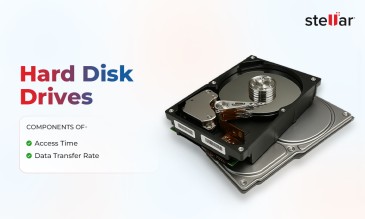These are times of insatiable appetites for storage space. Hard drives are ubiquitous.
Stellar’s hard drive data recovery service technicians perform 25,000+ data recoveries every year. Of these, 80% are hard drive data recoveries. These include—in almost equal proportion—laptop hard drives & SSDs, desktop hard drives, and external hard drives.
In every damaged or unresponsive hard drive, we see an intriguing mechanical, physical or logical puzzle lodged in a case. When our diagnostics reveal the problem, then begins the adventure of hard drive data recovery.
Why is Hard Drive Data Recovery Complex?
This is what a hard disk looks like from the inside.
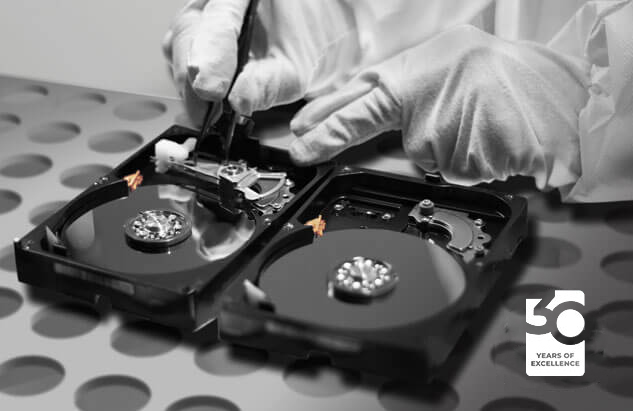
What you see is a neat stack of mechanical parts. What you don’t see is the fascinating orchestration of electro-mechanical forces that waltz effortlessly every time you open an MS Word document, copy an image, save a presentation, and
delete a PDF.
Data recovery is complicated because countless technical and mechanical challenges collide inside a hard disk. That’s true for laptop and desktop hard drives as well as portable external hard drive data recovery. We’ll discuss 3 of these challenges next.
1. Deteriorating Quality of Hard Disk Platter
Hard disk manufacturers, want to sell more laptop/desktop hard disks and external hard disks. In a competitive market, they must compete on price. Their constant drive to reduce manufacturing costs means we get affordable but mediocre hard disks. Ironically, the soul of the hard disk —the platter—isn’t immune to this cost-cutting. The worst kind of data recovery challenges results from platter damage. For you, a low-quality platter means that the threat of data loss is always potent.
At Stellar, we have data recovery professionals who can even recover data from surface-level scratches using proprietary techniques. This allows us to successfully recover data from hard disks where others would falter.
2. Complexity Posed by Data Encryption Technology
Hard drive manufacturers deploy advanced data encryption technologies. The purpose is to link the hard drive and the device it’s attached to. This prevents unauthorized access to the hard drive.
Most of the time these encryptions are system generated/default settings. Users aren’t aware of these settings. Nor do they know the login credentials necessary to decrypt the hard drive when it’s accessed by connecting to another device.
At Stellar, we understand these encryption mechanisms and the know-how to safely bypass or decrypt them when your hard drive is unresponsive. We know the login credentials of all hard drive models, from all hard drive manufacturers. This allows us to safely recover data from damaged encrypted hard drive's from all major manufacturers.
3. Moving Parts Inside the Hard Disk make it Vulnerable to Physical Damage
Imagine your hard disk as an elaborate complex of moving parts.
- The platter rotates at 5400 or 7200 rotations per minute.
- The mechanical arm that controls the read/write head moves swiftly to access different data sectors on the platter.
The slightest of shocks (such as a fall, a bump, or even erratic power supply causing sudden abortion of movements) can damage the parts of the hard disk.
If your hard drive has suffered a fall, bring it to us. Don’t attempt a DIY recovery; don’t attempt a software recovery; don’t entrust the drive to a small-scale recovery amateur.
Why Shouldn’t You Attempt Hard Drive Data Recovery on Your Own?
Here’s how to kill your data recovery chances in 5 steps?
- Google ‘how to recover data from hard disk’.
- Browse to YouTube videos from the search results.
- Watch videos having the most views.
- Use free (or freemium) data recovery software to attempt recovery.
- Fail in the process.
It’s likely that you’ll fail because data recovery isn’t as easy as installing software, pressing some buttons, and then selecting files to be recovered.
In some cases, the data recovery software executable file itself could occupy the drive sector where your accidentally deleted data resides. This means the deleted data could be wiped off forever (overwritten) and hence rendered irretrievable.
We’ve seen hard drives whose data is irredeemable because ineffective recovery software has resulted in damage to the hard drive platter beyond repair. Haste and amateurish overconfidence are lethal to their data recovery prospects. Sometimes these attempts lead to more complexity and due to these faulty attempts hard drive recovery cost increases.
Key takeaway: Only trust professional, tested, and proven-effective data recovery software. Also, before you download free or premium data recovery software, understand:
- How to determine whether your data recovery problem is logical or physical (the software will work only for logical deletion problems).
- How to safely recover data using recovery software by cloning your hard drive and then working on the cloned drive, not the original drive.
Every software package you install could overwrite crucial data from your hard drive, making recovery impossible from the overwritten sectors.
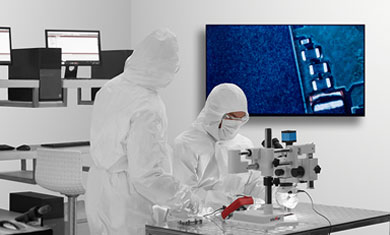
ISO certified Class 100 room environment, where various tasks are conducted on hard drives/storage media
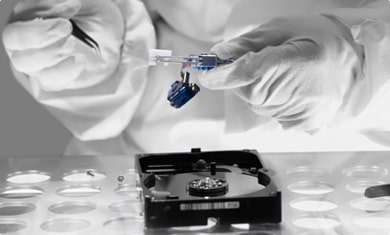
Data Recovery Expert doing parts transplantation on a hard drive in a controlled environment
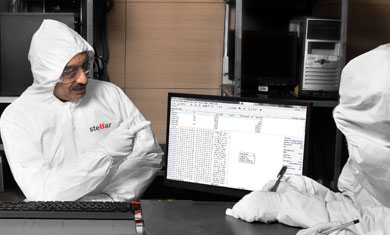
Data Recovery Expert manually checks the quality of recovered data to ensure that the recovered files are in best state
Why Shouldn’t You Trust an Amateur with your Hard Drive Data Recovery?
Some users don’t fall for the DIY data recovery trap. But they do something equally fatal.
- They Google for ‘hard drive data recovery near me’.
- Then, they deposit their hard drive at a makeshift data recovery center.
- An amateur data recovery ‘professional’ then dismantles your hard drive for basic diagnostics.
Invariably, this amateur data recovery practitioner will busy himself with trial and error. Next, two things can happen:
- During this trial and error, your hard drive will be damaged beyond recovery.
- In a rare event, the amateur might be able to recover the data (for instance, when the problem is as commonplace as dust-accumulation inside the hard drive).
Now, the shocking truth. It’s not uncommon for amateur data recovery practitioners to make lofty promises, fail at recovery, and then dismiss the exercise is ‘impossible’. Just so they won't look bad later, they inflict mischief on the hard drive platter and PCB. We find such cases of vandalism quite frequently.
Key takeaway: Data recovery hobbyists and amateurs lack the equipment, knowledge, and infrastructure to perform complex data recoveries. Each failed attempt means the chances of recovery will deplete. So entrust your hard drive to a professional data recovery service right on day 1.
How does Stellar Recover Data from Hard Disks in 80% of cases?
It’s because of the combined power of industry-leading infrastructure, state-of-the-art infrastructure, and nearly 30 years of experience in handling the most complex data recovery challenges.
Dismantling a hard drive inside a cabin or at home is rife with risks. Data recovery is done is in a Class 100 Clean Room. Otherwise, it’s almost guaranteed that the drive platter will be damaged. Let’s understand why.
- A hard disk is essentially a rotating platter that’s read from/written to by a moving read/write head.
- The distance between the tip of this moving head and the platter (flying height or floating height or head gap) is 0.002 inch (51 μm).
- A speck of dust is 1 to 100 µm in diameter.
- If a speck of dust lodges between the head and the platter, that’s curtains.
- The moving head will then scratch the platter surface and make your data irretrievable.
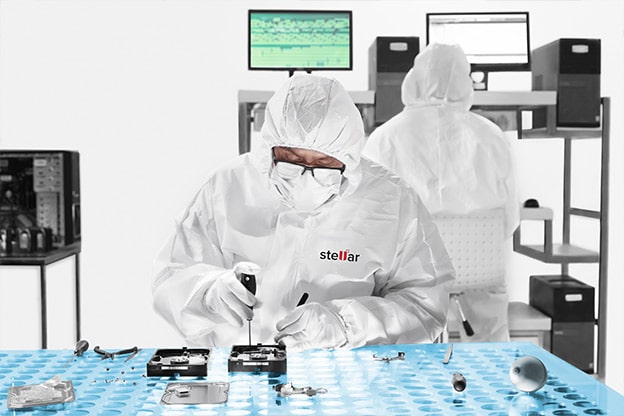
That’s why hard drives must be opened only inside a Clean Room. Experience life inside Stellar® Data Recovery’s ISO Certified Class 100 Clean Room Lab as brought to you by NDTV’s Prime Tech team.
We see our Clean Room as a spectacle of wits, dexterity, and logic. Everywhere you see, data recovery experts are hunched over a hard disk, fixing issues on the scratches of its platter, removing microscopic dust from its PCB, transplanting delicate read/write heads.
The Last Word on Hard Drive Data Recovery
You only get one chance to recover data. This one chance is your best chance
Don’t squander it under the misimpression created by DIY YouTube tutorials and amateur data recovery labs. If you value your data, trust Stellar, where we believe that your data is never lost. In 98% of cases, we’re correct.
Request a quote today. It’s the first step towards recovering your data.
Hard Drive Data Recovery At Stellar: FAQs
Unfortunately, data can be lost forever, and beyond recovery. Data recovery can be impossible when:
Deep scratches or other physical damage to the platter renders data sectors unreadable.
Data is overwritten by other data.
These situations are rare, and if you act quickly (and avoid unsafe DIY recovery tactics, it’s very likely your data will be recovered).
The honest answer is that we can only answer after inspecting the hard disk. Typically for logical data loss cases, data recovery is completed in 2-3 working days, whereas a physical recovery case can take min 2- 3 Weeks. Any professional who promises you a timeframe of 1-2 days for data recovery from a physically damaged hard drive may be deceiving.
We know that a damaged hard drive is like a black box from outer space. The nature, extent, and severity of damage are only known after initial basic diagnostics. Generally, we can recover data from your hard disk within 7-10 days.
No. After we diagnose your hard disk’s problems, we issue a quotation, which is payable 50% in advance. This advance payment is fully protected by Stellar's industry-first 'No Recovery, No Charges' policy. If we recover your data, you then complete the payment, else we refund the advance. These terms are amongst the fairest in the professional data recovery market.
That’s because such professionals don’t have the required infrastructure, equipment, and technology. The moment they open your hard drive, it’s exposed to dust. Within moments, your hard drive platter could become damaged beyond repair and its data lost beyond recovery. Read More
The business model of small-scale data recovery professionals works as follows. Promise free diagnostics, perform basic checks, accept the recovery challenge if the problem is evident, else return the hard disk. This reduces unpredictability for them but imposes a burden on you. Their unscientific and hasty trial and error worsen the damage to your hard disk. Read More
About The Author

Sr. Online Marketing Executive and Content Writer at Stellar Data Recovery.








